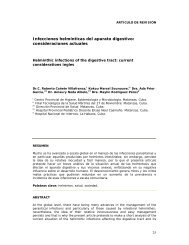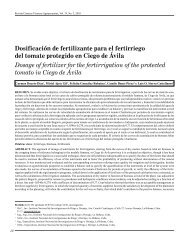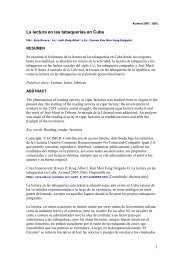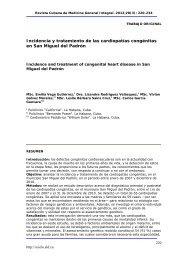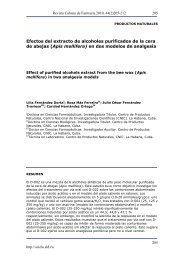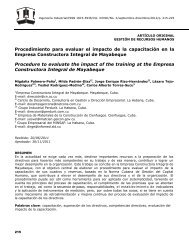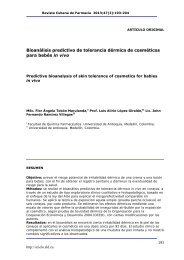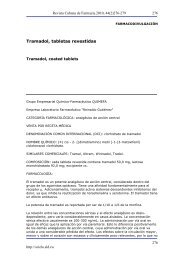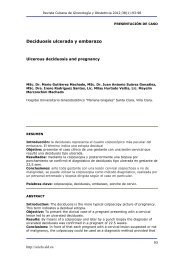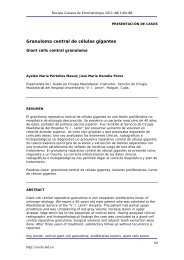Midazolam en la sedación paliativa terminal de ... - SciELO - Infomed
Midazolam en la sedación paliativa terminal de ... - SciELO - Infomed
Midazolam en la sedación paliativa terminal de ... - SciELO - Infomed
Create successful ePaper yourself
Turn your PDF publications into a flip-book with our unique Google optimized e-Paper software.
Revista Cubana <strong>de</strong> Medicina. 2011; 50(4):359-375ABSTRACTObjective: To <strong>de</strong>scribe the use of midazo<strong>la</strong>m in cancer pati<strong>en</strong>ts during the <strong>la</strong>st daysof life, as part of an assistance strategy of <strong>terminal</strong> palliative sedation.Methods: A retrospective and <strong>de</strong>scriptive study was conducted in 30 pati<strong>en</strong>ts treatedin the Oncology Service of the "Hermanos Ameijeiras" Clinical Surgical Hospital fromAugust, 2007 to <strong>de</strong>cember, 2010 with a histological diagnosis of cancer and refractorysymptoms in <strong>terminal</strong> stage of disease, aged ≥ 18 and a life exp<strong>en</strong>tancy less than 2weeks. Previously, the write informed cons<strong>en</strong>t was obtained from pati<strong>en</strong>t and/orre<strong>la</strong>tives for the prescription of midazo<strong>la</strong>m hydrochlori<strong>de</strong> (10 mg). Doses, ways androutes of administration were variable and in <strong>de</strong>p<strong>en</strong>d<strong>en</strong>ce of severity of symptoms,experi<strong>en</strong>ce of physician responsible of the case and prefer<strong>en</strong>ces of pati<strong>en</strong>ts and/orre<strong>la</strong>tives.Results: Dyspnea and agitation were the more frequ<strong>en</strong>t refractory symptoms,whereas 12 pati<strong>en</strong>ts showed two or more symptoms. The subcutaneous route was themore used and in more than 70% of pati<strong>en</strong>ts the drug intermitt<strong>en</strong>t way ofadministration was the used one. Survival time, after the drug administration was of56,7% at 48 h and 5 pati<strong>en</strong>ts had a survival of 4 days. The dose rank used was thatof 10-60 mg/d in the case of midazo<strong>la</strong>m. The lowest doses were used wh<strong>en</strong> there waspredominance of anxiety symptoms, less refractory symptoms, the subcutaneousroute and home administration.Conclusions: The <strong>terminal</strong> palliative sedation using midazo<strong>la</strong>m account for theclinical need of controlling a intolerable symptomatic situation with an effectiveresponse and its administration is safe. This is the first report on the use of a drug for<strong>terminal</strong> palliative sedation in cancer pati<strong>en</strong>ts in our country.Key words: Palliative sedation, palliative cares, midazo<strong>la</strong>m.INTRODUCCIÓNEl cáncer es <strong>la</strong> principal causa mundial <strong>de</strong> mortalidad. Más <strong>de</strong>l 70 % <strong>de</strong> <strong>la</strong>s<strong>de</strong>funciones por cáncer ocurr<strong>en</strong> <strong>en</strong> países <strong>de</strong> ingresos bajos y medianos, y se estimaque el número <strong>de</strong> <strong>de</strong>funciones anuales mundiales por esta causa seguirá aum<strong>en</strong>tandoy llegará a unos 12 millones <strong>en</strong> el 2030. El cáncer <strong>en</strong> Cuba constituye <strong>la</strong> segundacausa <strong>de</strong> mortalidad g<strong>en</strong>eral y <strong>la</strong> primera <strong>de</strong> años pot<strong>en</strong>ciales <strong>de</strong> vida perdidos, es <strong>la</strong>causa <strong>de</strong> mayor impacto <strong>en</strong> <strong>la</strong> esperanza <strong>de</strong> vida al nacer. 1La at<strong>en</strong>ción a los paci<strong>en</strong>tes <strong>en</strong> situación <strong>terminal</strong> cobra mayor importancia para elsistema sanitario y para toda <strong>la</strong> sociedad, por el progresivo <strong>en</strong>vejecimi<strong>en</strong>to <strong>de</strong> <strong>la</strong>pob<strong>la</strong>ción, el increm<strong>en</strong>to <strong>de</strong> <strong>la</strong> morbilidad <strong>en</strong> los últimos meses <strong>de</strong> <strong>la</strong> vida, el aum<strong>en</strong>to<strong>de</strong> <strong>la</strong> mortalidad por cáncer, <strong>la</strong> <strong>de</strong>manda cada vez mayor <strong>de</strong> los servicios <strong>de</strong> urg<strong>en</strong>ciapor parte <strong>de</strong> los paci<strong>en</strong>tes y sus familiares, así como <strong>la</strong> escasez y/o insufici<strong>en</strong>cia <strong>de</strong>cuidadores formales o informales para <strong>la</strong> at<strong>en</strong>ción <strong>de</strong> este tipo <strong>de</strong> <strong>en</strong>fermo. 2La Organización Mundial <strong>de</strong> <strong>la</strong> Salud re<strong>de</strong>fine el concepto <strong>de</strong> cuidados paliativos (CP)al <strong>de</strong>scribir este tipo <strong>de</strong> at<strong>en</strong>ción como: "Un <strong>en</strong>foque terapéutico, por el cual sehttp://scielo.sld.cu360



